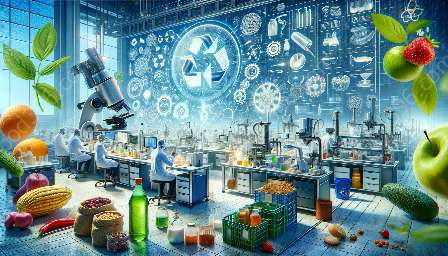Microorganisms in food play a crucial role in food microbiology and have a significant impact on the quality, safety, and preservation of food. Understanding the presence and behavior of microorganisms in food is essential for ensuring food safety and developing effective food preservation methods. This topic cluster aims to provide a comprehensive exploration of the role of microorganisms in food, covering various aspects related to food microbiology, food science, and technology.
The World of Microorganisms in Food
Microorganisms are tiny living organisms that are present in all environments, including the food we consume. They include bacteria, yeasts, molds, and viruses, and their impact on food can be both beneficial and detrimental. In food microbiology, the study of microorganisms in food focuses on understanding their behavior, interactions, and effects on food safety and quality.
Diversity of Microorganisms in Food
The world of microorganisms in food is incredibly diverse, with countless species and strains that can inhabit and interact with various types of food. Bacteria, such as Lactobacillus and Escherichia coli, play essential roles in fermentation and food spoilage, while yeasts, like Saccharomyces cerevisiae, are crucial for the production of bread, beer, and wine. Meanwhile, molds, including Aspergillus and Penicillium species, can cause food spoilage and produce mycotoxins, posing serious food safety concerns.
Impact on Food Safety
Microorganisms in food have a direct impact on food safety, as some species can cause foodborne illnesses and pose health risks to consumers. Pathogenic bacteria, such as Salmonella, Campylobacter, and Listeria monocytogenes, are notorious for contaminating food and causing foodborne diseases. Additionally, viruses like norovirus and hepatitis A virus can also be transmitted through food, highlighting the critical importance of preventing and controlling microbial contamination in the food supply chain.
Microbial Food Spoilage
Another significant impact of microorganisms in food is food spoilage, which can result in changes to the sensory properties and safety of food products. Spoilage microorganisms, including bacteria, yeasts, and molds, thrive in various food environments and can cause undesirable changes, such as off-flavors, odors, and texture deterioration. Understanding the causes and mechanisms of microbial food spoilage is essential for developing effective preservation and shelf-life extension strategies.
Quality and Preservation Considerations
Microorganisms also play a crucial role in determining the quality and shelf life of food products. In food science and technology, understanding the interactions between microorganisms and food matrices is essential for developing and optimizing preservation methods, such as pasteurization, sterilization, refrigeration, and novel non-thermal technologies.
Beneficial Microorganisms
Not all microorganisms in food are harmful; some can actually contribute to improving food quality and safety. Probiotic bacteria, such as Lactobacillus and Bifidobacterium species, are known for their positive effects on gut health and have been incorporated into various functional food products. Additionally, certain lactic acid bacteria and molds are used in the production of fermented foods, such as cheese and yogurt, contributing to their unique flavors and textures.
Preservation Techniques
To ensure the safety and quality of food products, a variety of preservation techniques are employed to control the growth and activity of microorganisms. Thermal processing methods, such as canning and pasteurization, aim to destroy pathogenic and spoilage microorganisms while maintaining nutritional and sensory attributes. Meanwhile, innovative techniques, including high-pressure processing, pulsed electric fields, and ozone treatment, are continually being explored for their potential in extending the shelf life of perishable foods.
Conclusion
The complex relationship between microorganisms and food underscores the importance of understanding their impact on food safety, quality, and preservation. By delving into the world of microorganisms in food, we gain valuable insights that can inform the development of innovative strategies for ensuring safe, high-quality, and sustainable food production and consumption.

